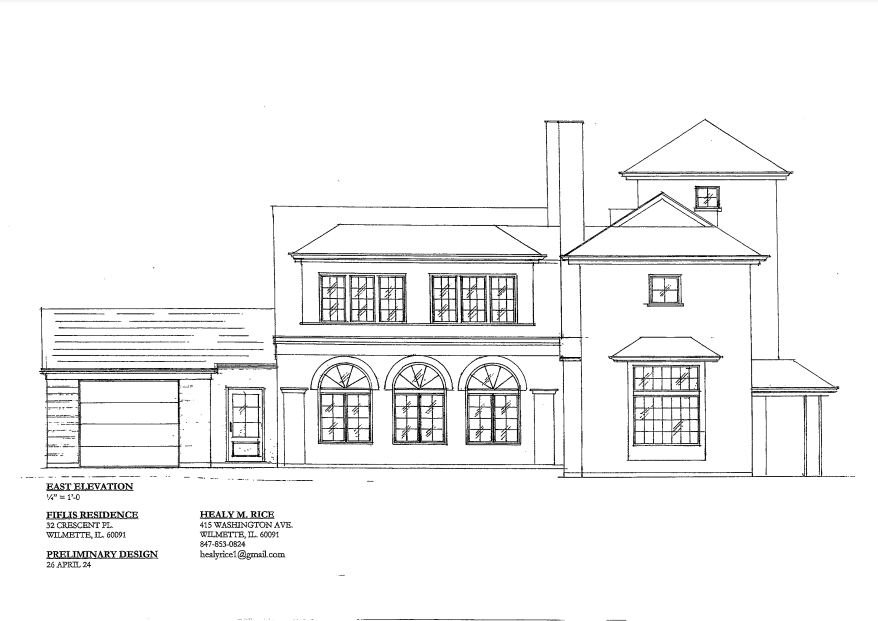
Vocal neighbors contribute to denial of residential addition, garage
Wilmette trustees shut the door on a family’s request to add a one-car garage addition to the rear of their home that several neighbors argued would change the character of a beloved block in town.
Wilmette’s Village Board during its Tuesday, June 25 meeting unanimously voted against the family’s proposal to construct a one-story addition to their home on the southwest corner of Crescent Place and Broadway Avenue that would add a garage and mudroom to the property.
The request, made by Wilmette residents Sydney Schneider and Peter Fiflis, narrowly garnered enough support from the village’s Zoning Board of Appeals earlier this month, when commissioners voted 4-3 to recommend approval.
Zoning commissioners grappled with what many described as a “difficult case,” but ultimately found enough solace in one of the family’s key arguments that not having a garage on the property limits their “reasonable use” of the home.
As part of their plans, the applicants suggested accessing the proposed garage by a new curb cut on Broadway Avenue, according to village documents. The existing curb cut and front yard parking area on the property located on Crescent and front walk to Broadway would be removed, per project plans.
During their presentation to the zoning board as well as in written correspondences to the village, the family cited the “extremely unique” nature of the property as one of the key components of how the request satisfies the standards needed for the requested zoning reliefs associated with the proposal.
According to the family’s proposal, their home, which is a corner lot, is the only house on Broadway with no alley access and they argued it’s one of the few in east Wilmette without a garage.
The project’s architect, Healy Rice, also told trustees during the meeting that all other lots on Crescent except for the neighbor immediately to the west have alley access and garages accessing from the alley. Rice also added that all other homes on Broadway have alley access and two- and three-car garages connected to the alleys.
The applicants’ request drew particular opposition from the owners of its closest neighboring property in the 200 block of Broadway. The home’s owners, Robert and Val Jambois, cited several contentions, including the proximity of the proposed addition to their property.
In a letter submitted to the zoning board, the Jamboises stated the addition would be “mere feet” from their home. This, they said, would diminish both the value of their property and the enjoyment of their home.
Several neighbors, both in-person during the public comment portion of the June 25 meeting and through written correspondences, joined the Jamboises in arguing that the garage addition would also “alter the essential character of the neighborhood.”
Approximately 20 comments were submitted to village officials with the overwhelming majority opposing the project. Eleven nearby residents spoke during public comment on June 25.
Paul Nowicki, who lives three houses south of the subject property, told trustees that he believes the proposed addition would “impact the entire block.”
“The neighbors have spoken against this variance,” he said. “ … Protect the architectural integrity of our street.”
Emily Bewley, who lives two houses down on Broadway, told trustees that she and other neighbors hope another alternative can be found. She added that the addition would be “terrible for our neighborhood as a whole.”
Charles Turk, who has lived on Broadway since 1979, called the street “an aesthetic marvel.”
“I’m respectfully asking you trustees to do your job as trustees and hold and trust the aesthetic that was developed (for Broadway).”
Resident Lynne Miller, who lives just west of the subject property, spoke in support of her neighbor’s garage request.
Miller said her and her husband primarily support the project “for safety reasons.”
Because of the configuration of the property’s existing parking pad and driveway, Miller said cars coming from the east are not visible and it has created an “unsafe situation for many years now.” Miller noted that the addition would provide “much safer street access for both of our families as well as for traffic in the area.”
Although the board ultimately was unanimous in opposition, all of the board members detailed the difficulty they had in reaching a decision.
Several of the trustees shared sentiments that they did not agree that the absence of a garage meets the required hardship standard needed for zoning variations. Multiple trustees described their view of this as an “inconvenience” as opposed to a hardship.
“Would I consider it a hardship to live without a garage and a mudroom? I would consider it an inconvenience, not a hardship,” Trustee Stephen Leonard said.
Trustee Kate Gjaja called it “a really hard” decision, adding that the board “hates when we see a neighborhood come to this point.”
Gjaja noted that she believed the proposal was not “in the best interest of the community” and that the request did not meet all the necessary standards. She noted particular concern with the standard that related to the neighboring property, calling it “an unreasonable ask of the neighbor.”
The size of the property’s lot related to the scale of the home was another factor that trustees cited as a reason for opposition.
The previous homeowners completed an addition in 2001 that more than doubled the size of the residence. As part of the process behind that addition, the owners opted to not add a garage and instead put the parking pad in the front.
Board members expressed strong opinions that the lot is already at its capacity.
“If I could find a way to give you a garage on this lot that I think would be a good fit and would not be a determinant to your neighbors or the community, I really would,” Village President Senta Plunkett said. “But, in this case, I just don’t see how this can fit.”
“I think we all feel that this lot is as full as it can get and that this addition, albeit as lovely and trying to make it as small as possible, is just too much for this,” she later added.
Schneider and Fiflis purchased the home approximately 11 months ago in 2023, they said at the meeting.
The Record is a nonprofit, nonpartisan community newsroom that relies on reader support to fuel its independent local journalism.
Become a member of The Record to fund responsible news coverage for your community.
Already a member? You can make a tax-deductible donation at any time.

Martin Carlino
Martin Carlino is a co-founder and the senior editor who assigns and edits The Record stories, while also bylining articles every week. Martin is an experienced and award-winning education reporter who was the editor of The Northbrook Tower.


